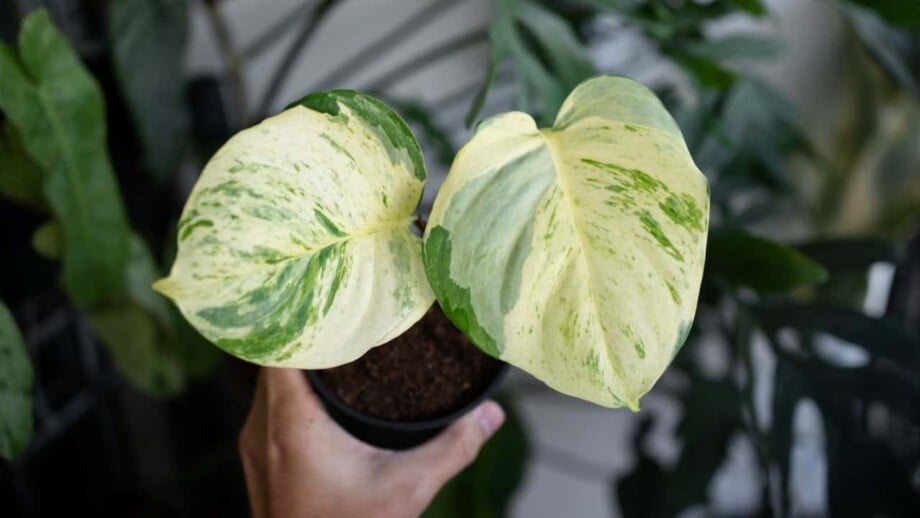Are you looking for a low-maintenance plant that can add some beautiful greenery to your home or office? Look no further than the Manjula Pothos! This popular houseplant boasts bright, variegated leaves that can brighten up any space.
With straightforward care, Manjula pothos is a fabulous, variegated member of Epipremnum aureum to add to your indoor plant collection. I believe it’s the perfect plant for those looking to get started in the beautiful world of tending houseplants, as it is considered one of the easiest plants you could ever hope to grow.
Besides its lovely bright foliage, the Manjula pothos also has an air-purifying capacity, making it a highly coveted indoor houseplant. And even though this plant can grow outdoors as well, it shouldn’t be raised under cold conditions.
Manjula pothos usually have a slow growth process due to the cream, silver, and white variegation in their leaves. Meaning that less chlorophyll in the leaves equals less food for faster growth. And so, it’s a low-growing, trailing, and compact plant that cascades with dense foliage.
Due to its rare status, the Manjula pothos is more challenging to come by than other pothos; if you want to get a hold of one, contact plant collectors or check out rare plant shops.
With big undulating green leaves fused with splashes, dapples, and swirls of white, the Manjula pothos can brighten up any space while being patient with the “not-so-green” fingers. That being said, let’s dive in and learn how to keep your Manjula pothos happy.
If you’re interested in learning how to plant, grow, and care for manjula pothos, then keep on reading!

Botanical Name: Epipremnum aureum ‘HANSOTI14’
Common Name: Manjula pothos, jewel pothos, happy leaf pothos, and HANSOTI14
Family: Araceae
Plant Type: Perennial, vine
Hardiness Zones: 11 – 12 (USDA)
Sun Exposure: Partial indirect sunlight
Soil Type: Loamy, moist, but well-drained
Soil pH: Acidic
Height: Up to 6 – 10 feet
Bloom Time: Spring and summer
Native Area: Southeast Asia, Australia
Quick Guide: Planting, Growing & Caring for Manjula Pothos
- Manjula pothos is an easy to grow pothos that features sunning variegation that can brighten up any space.
- They appreciate more light than their non-variegated pothos varieties, which is key to maintaining their stunning variegation.
- Proper watering is key to avoid issues such as root rot. Water your Manjula pothos when the top 1 to 3 inches of soil to dry out.
- It can adapt to different lighting conditions, but harsh direct sunlight can burn Manjula’s leaves.

Manjula Pothos Care
Manjula pothos, also known as ‘Happy Leaf Pothos,’ is a plant with a cheerful and vigorous spirit. It is characterized by its wavy edge and big heart-shaped leaves with cream, white and green marbling, which makes it look like N-joy and Marble Queen pothos love child.
Like tropical and evergreen perennials, Manjula pothos is part of the Araceae family and is a mutated type of pothos. Originally from India, this plant’s scientific name is Epipremnum Aureum Manjula, and its patent, Epipremnum’ HANSOTI14 (named after the guy that made it)’ was registered by the University of Florida.
It’s often incorrectly identified as a Florida plant, as it is aesthetically similar to Pearl and Jade Pothos. And despite its breathtaking appearance, Manjula pothos -and pothos plants generally- are easy to take care of. All types of pothos are adaptable and resilient and thrive in normal household growing conditions.
Due to its exceptional level of variegation, Manjula pothos appreciates more light conditions than non-variegated pothos varieties, but their care is very similar to the standard golden pothos.
I’ve found that providing Manjula Pothos with the right amount of light is key to maintaining its stunning variegation. They thrive best in bright, indirect light.
Although they can tolerate lower light conditions, I make sure to give them a spot with moderate to bright light to truly showcase their leaf patterns. However, I’m always mindful to shield them from direct sunlight, as it can scorch their delicate leaves.
I’ve learned that this rare beauty adores a warm location that receives bright indirect light which helps to maintain its growth and variegation and other simple care.
In the wild, they can grow up to 66 feet long, but as a houseplant, they typically grow to be around 6-10 feet long.
Light
Manjula can adapt to different lighting conditions, but harsh direct sunlight can burn Manjula’s leaves. While this plant can survive in low light conditions, it requires more light than other pothos varieties in order to keep the leaf’s variegation. So aim for indirect light when deciding where to place your Manjula pothos.
Lighting is a critical component when growing Manjula pothos indoors because lower light conditions reduce the intensity of the Manjula pothos leaves’ variegation. Indirect bright light is ideal for the best care of this plant.
This makes them the perfect plant for areas in your home that don’t receive direct sunlight, such as near a north-facing window. If you want to promote even growth and keep your plant looking its best, rotate it every once in a while so that it gets light on all sides.
Remember, the more light a Manjula Pothos receives, the more variegation it will have.

Soil
Preferably -like most tropical houseplants- the Manjula pothos soil needs to be well-draining and loamy. A regular soil mix works well with this plant, but avoid clumpy soil mix that can easily become soggy, impede root growth, and lead to root rot.
To ensure excellent drainage, I opt for a well-balanced combination of potting soil, perlite, and either peat moss or coconut coir. This blend provides them with the ideal growing medium to support their root system.
When I notice the plant becoming root-bound, typically every one to two years, I make sure to repot it into a slightly larger container to accommodate its growth.
You can also create your own soil by mixing an equal portion of perlite, organic substrates (like orchid bark and peat moss), and fresh garden soil, or get a potting mix high in coco coir. A neutral ph is recommended for this plan (6.1-6.5).
Like all pothos, the Manjula soil mix must be light, loamy, airy, and well-drained. The Manjula soil requirements are somewhat paradoxical; they need excellent drainage soil but also need adequate water retention and moisture, as they like their setting to be moisturized but not excessively.
Water
I’ve learned that finding the right balance of moisture for Manjula Pothos is crucial. For proper Manjula pothos watering, you must allow the top 1 to 3 inches of soil to dry out in between waterings and then water throughout.
Manjula pothos isn’t particularly drought tolerant, but it can withstand a little neglect if necessary. If you forget to water your plant, it should bounce back easily when watered again.
To keep your Manjula happy, place it in a pot with a drainage hole, so any excess water will flow out the bottom, and keep it strictly a no-soggy soil zone to keep your Happy Leaf Pothos root rot free.
If you notice your plant’s leaves turning yellow, this could be a sign of overwatering. On the other hand, if the leaves are wilting and the soil is dry, it’s time to water your plant.
Temperature and Humidity
A household’s standard temperature and humidity levels should be ok for Manjula pothos. They enjoy temperatures between 60-85 degrees Fahrenheit and a relative humidity of around 50%.
If your home is particularly dry, consider investing in a humidifier or placing a tray of water near your plant to help increase the humidity. During the winter, keep your plant away from cold drafts and heat sources such as radiators.
To create a conducive atmosphere, I maintain average room humidity levels, but I’ve noticed that these beauties truly appreciate higher humidity. So if you want your plant to grow more vigorously, provide it with extra humidity. And so, laundry rooms, bathrooms, or kitchens are great for growing your happy leaf or you can place it near a humidifier.
Low light conditions can reduce the leave’s variegation. If Manjula pothos gets exposed to warm and sunny temperatures, it will stop producing variegated leaves and will turn completely green.
Fertilizer
This tropical plant does not require regular fertilization, although consistent feeding during spring and summer helps with healthier growth and variegation. You can apply a balanced liquid fertilizer once or twice a month during the active growing season for better results.
Using fertilizers is not crucial for Manjula pothos compared to using the right kind of soil. When the right medium is used, it compensates for the need for additional nutrients, not support plant growth. Nevertheless, giving your happy leaf pothos an extra boost especially during active growing season goes a long way.
Pruning
Regular pruning can help keep your Manjula Pothos looking neat and tidy. Use clean, sharp shears to trim back any vines that are getting too long or tangled. You can also remove any yellowing or dead leaves to promote new growth.

How to Plant and Grow Manjula Pothos
How to Propagate Manjula Pothos
Stem Cuttings are the easiest way to propagate the Manjula pothos plant. Taking cuttings can help you grow new plants, share them with your friend, and encourage fuller growth on your plant, as every cut stem will start to branch.
You can also repot rooted cuttings back into the original pot to make your plant bigger rather than creating new plants. To propagate your happy lead pothos by stem cutting, follow these easy steps:
- Cut stems that are 4 to 5 inches long, and ensure that you cut them right below a node/leaf
- Remove all leaves from the bottom half, and submerge the exposed stem in water using a container
- Place your cuttings in a place where they can get bright, indirect sunlight, and replace the water every 5 to 10 days to ensure the new plant stays fresh
- After a couple of weeks, roots begin to grow, and once the roots are at least 1 inch long, you can replant the cuttings in a well-draining and pre-moistened potting mix.
- Keep all cutting evenly moist for the first two weeks after planting to help the roots acclimate to their new soil. Then start to resume a regular watering schedule.
How to Pot or Repot Manjula Pothos
When it comes to potting and repotting Manjula Pothos, there are a few things to keep in mind. Manjula pothos generally prefer to be root-bound, so you don’t need to repot them very often. However, if you notice the roots starting to grow out of the drainage holes or the plant becoming top-heavy, it’s time to repot.
When choosing a pot for your Manjula pothos, it’s best to go for a slightly larger pot than the current one. This will give the plant room to grow without overwhelming it with too much soil. Make sure the pot has drainage holes, as waterlogged soil can lead to root rot.
When repotting, gently remove the plant from its current pot and loosen any tangled roots. Add a layer of soil to the new pot and place the plant on top, making sure the roots are spread out evenly. Fill in the gaps with soil, leaving a bit of room at the top for watering.
It’s best to repot Manjula Pothos in the spring, as this is when the plant is actively growing. After repotting, water the plant thoroughly and place it in a bright, indirect light. You can fertilize the plant every few months with a balanced fertilizer to encourage healthy growth.
With proper care, your Manjula Pothos will thrive in its new pot and continue to add beauty to your indoor space.

Common Pests and Plant Diseases for Manjula Pothos
Pothos and houseplants, in general, are susceptible to pests like fungus gnats, mealybugs, spider mites, and scale. Fortunately, there are ways to combat these pests and keep your Manjula pothos healthy. Regularly check your plant for signs of infestation, such as webbing or cotton-like spots on the leaves.
If you do notice an infestation, use a gentle insecticidal soap or neem oil to combat the pests. Be sure to follow the instructions on the product carefully to avoid harming your plant.
Like most plants, this pothos does not do well with soggy roots. You can identify a root rot problem if you notice your plant has brown leaves, wilting stems, and is withering. Check your plant’s roots and if they’re black, brown, or mushy, remove the rotten roots as soon as possible, and your plant should bounce back up.
Most of the time, Manjula pothos diseases are related to improper care techniques. For example, very humid environments can lead to fungal and bacterial growth; overwatering can lead to root rot, leaf spot, and botrytis.
According to the University of Florida, Manjula pothos’ most common disease is phytophthora root rot, which causes leaves to turn black or dark brown.
The best disease control is exclusion and pruning off the infected plant parts. You can also use neem extract or other horticultural oils to wipe the leaves to prevent further infection.
Yellowing leaves can also be a sign of disease in Manjula Pothos. This can be caused by overwatering or too much direct sunlight. If you notice your plant’s leaves turning yellow, adjust your care routine accordingly.
Troubleshooting Problems For Manjula Pothos Care
As with all pothos plants, the Manjula pothos is a generally problem-free and low-maintenance plant. However, improper care or pest infestation can lead to different issues. Let’s look at some of the most common ones and how to deal with them:
Yellow Leaves
Yellow leaves on all pothos varieties, most of the time, are a result of disease or root rot. But it can also signify that your happy leaf plant is not receiving enough light. Try moving your Manjula to a brighter location.
Brown Leaves
This is a common indication that your Manjula pothos is drying out. Sometimes in overly dry conditions, the leaf tips will begin to dry. Try increasing your plant’s humidity and water it more frequently.
Green Leaves
Like all variegated pothos, the Manjula can turn green if it’s placed in low light conditions for a prolonged period.
Remember that the Manjula pothos needs bright indirect light to keep its variegation. If your Manjula pothos is turning green, place it in a bright, indirectly lit area.
Drooping Leaves
Drooping and wilting leaves indicate that yous Manjula pothos plant is thirsty and needs water. Water your plant throughout, and your happy leaf plant should bounce back up within one or two hours.
Brown Spots
This is a sign that your plant is being overfertilized, overwatered, receiving overly intense direct sunlight, root problems, or pest problems.
Avoid overwatering your plant by keeping it on a regular watering schedule. And water only after testing the soil (as explained before).
If this problem is being caused by overfertilizing, flush the plant from the top for several minutes with water until it comes out the drain hole, and let the pot sit still until it is completely drained.
Is a Manjula Pothos Toxic?
As we know, happy leaf plants are such a joy to grow, but despite that, manjula pothos plants are considered toxic, as are all pothos varieties.
If the leaves of this plant are ingested, you can suffer from gastrointestinal problems like stomach pains, nausea, and vomiting. And besides gastrointestinal problems, excessive salivation, drooling, and painful sores in the mouth are other symptoms resented when Manjula pothos is ingested.
All pothos plants are also toxic to animals; even though some reptiles don’t seem to present many symptoms, domestic animals like dogs or cats will respond violently right after ingestion in similar ways to humans. The problem with Manjula pothos ingestion is that it can easily kill animals if they ingest the plant or any pothos variety.
If you have a pet that likes to chew plant leaves, find a way to keep your Manjula well out of its reach. You can also throw some orange or lemon peels into the pot to keep your pets away and it also works as fertilizer.
Other Pothos Guides by Planet Natural:











